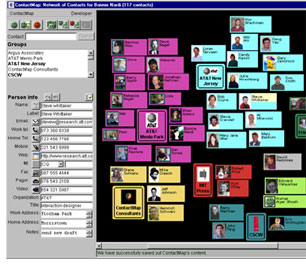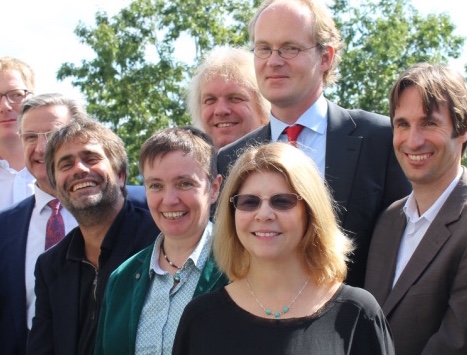 |
|||||||||
 |
 |
||||||||
I am a faculty member in the Department of Informatics
in the Donald Bren School of Information and Computer Sciences at the
University of California, Irvine. In 2014, I was awarded an honorary doctorate, “Doctor Honoris Causa,” from the University of Umeå in Sweden, for which I am very grateful. I was elected to the CHI Academy in 2013. I co-edit, with Kirsten Foot and Victor Kaptelinin, the MIT Press Acting with Technology Series which has many award-winning titles. I am a founding member of the ICS Center for Research on Sustainability, Collapse-preparedness and Information Technology at UC Irvine and of the Computing within LIMITS Workshop.
New Book!
My newest book, just published by MIT Press, and co-authored with Hamid Ekbia at Indiana University, is Heteromation and Other Stories of Computing and Capitalism. It’s not long but we worked on it a long time.
Newer Books
Ethnography and Virtual Worlds: A Handbook of Method
Tom Boellstorff, Bonnie Nardi, Celia Pearce, T.L. Taylor
Foreward by George Marcus
Princeton University Press, September 2012
Activity Theory in HCI Research: Fundamentals and Reflections
Victor Kaptelinin, Bonnie Nardi
Morgan & Claypool Spring 2012
Materiality and Organizing: Social Interaction in a Material World.
Paul Leonardi, Bonnie Nardi and Jannis Kallinikos
Oxford University Press, November 2012
Areas of interest:
![]()
 Activity
theory proposes that consciousness is shaped by practice, that people
and artifacts mediate our relationship with reality. Consciousness is
produced in the enactment of activity with other people and things, rather
than being something confined inside a human head. Activity theory began
in Russia with the work of Lev Vygotsky in the 1920's, continuing through
his student Aleksey Leontiev, and then through students of Leontiev. This
work has been influential in education, organizational design, and interaction
design. Activity theory works well with design because activity theorists
have always tested their theories in practical ways and believe that application
is an outcome of theory, not a separate activity. In some of my writings
I have discussed how, as a psychological theory, activity theory can be
scaled to collaborative settings without losing sight of individual participants
in an activity.
Activity
theory proposes that consciousness is shaped by practice, that people
and artifacts mediate our relationship with reality. Consciousness is
produced in the enactment of activity with other people and things, rather
than being something confined inside a human head. Activity theory began
in Russia with the work of Lev Vygotsky in the 1920's, continuing through
his student Aleksey Leontiev, and then through students of Leontiev. This
work has been influential in education, organizational design, and interaction
design. Activity theory works well with design because activity theorists
have always tested their theories in practical ways and believe that application
is an outcome of theory, not a separate activity. In some of my writings
I have discussed how, as a psychological theory, activity theory can be
scaled to collaborative settings without losing sight of individual participants
in an activity.
I am a Senior Editor for Mind, Culture, and Activity, a journal devoted to activity theory.
Related publications
| Making HCI theory work: An analysis of the use of activity theory in HCI research. The impact of activity theory in HCI, with Torkil Clemmensen and Victor Kaptelinin. 2016 |
| Appropriating Theory. This chapter in Diane Sonnenwald’s book is a personal account of my journey with activity theory. 2015 |
| Affordances in HCI: Toward a Mediated Action Perspective 2012 |
| Ensembles: Understanding the Instantiation of Activities. 2009 |
| Acting with Technology: Activity Theory and Interaction Design, with Victor Kaptelinin, MIT Press 2006 |
| NetWORKers and their Activity in Intensional Networks 2002 |
| Co-editor, special issue of Computer-supported Cooperative Work, "Activity Theory and the Practice of Design," with David Redmiles. Volume 11(1-2) 2002 |
| Co-editor, special issue of Computer-supported Cooperative Work, "A Web on the Wind: The Structure of Invisible Work," with Yrjo Engeström. Volume 8 (1-2) 1998 |
| Context and Consciousness: Activity Theory and Human-computer Interaction, MIT Press 1996 |
![]()
 My most fun research concerns video games! Some of the research is on very serious topics in social media.
My most fun research concerns video games! Some of the research is on very serious topics in social media.
Related publications

 The
computer desktop was an amazing design for its time, but does not reflect
the complexity, flexibility, and sociality of human activity. Based on
my research, I have developed several designs that I believe would enhance
the desktop, if it were possible to take them past the prototype stage
and onto actual desktops. I hope the ideas will find their way into the
designs of others. Eventually we will have to reorganize the desktop to
reflect the complex mix of activities users engage in and move beyond
the rigidity of separate applications and files-and-folders. Activity
theory will be useful in this effort as we work to characterize activity.
While ingenious technologies such as blogs and wikis have improved communication,
we need better ways to use digital technologies to organize multiple activities,
establish meaningful contexts for different activities, and collaborate
with others. A different level of design and implementation is needed
to make that happen.
The
computer desktop was an amazing design for its time, but does not reflect
the complexity, flexibility, and sociality of human activity. Based on
my research, I have developed several designs that I believe would enhance
the desktop, if it were possible to take them past the prototype stage
and onto actual desktops. I hope the ideas will find their way into the
designs of others. Eventually we will have to reorganize the desktop to
reflect the complex mix of activities users engage in and move beyond
the rigidity of separate applications and files-and-folders. Activity
theory will be useful in this effort as we work to characterize activity.
While ingenious technologies such as blogs and wikis have improved communication,
we need better ways to use digital technologies to organize multiple activities,
establish meaningful contexts for different activities, and collaborate
with others. A different level of design and implementation is needed
to make that happen. There
is a strong need to find new ways to think about the social and cultural
changes that come with new technologies and to think about new technologies to address pressing social problems. My current work concerns labor and computing and long-term environmental sustainability.
There
is a strong need to find new ways to think about the social and cultural
changes that come with new technologies and to think about new technologies to address pressing social problems. My current work concerns labor and computing and long-term environmental sustainability.




